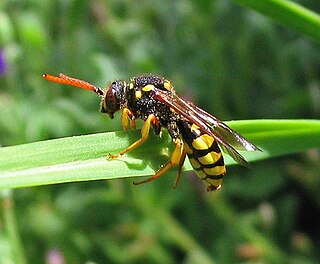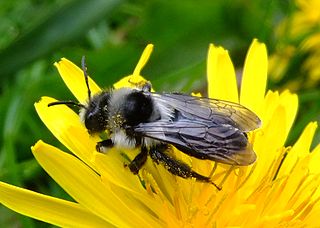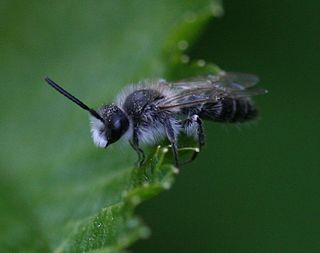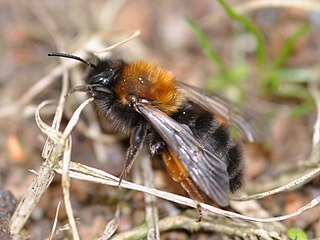
With over 850 species, the genus Nomada is one of the largest genera in the family Apidae, and the largest genus of cuckoo bees. Cuckoo bees are so named because they enter the nests of a host and lay eggs there, stealing resources that the host has already collected. The name "Nomada" is derived from the Greek word nomas, meaning "roaming" or "wandering."

Andrena is a genus of bees in the family Andrenidae. With over 1,500 species, it is one of the largest genera of animals. It is a strongly monophyletic group that is difficult to split into more manageable divisions; currently, Andrena is organized into 104 subgenera. It is nearly worldwide in distribution, with the notable exceptions of Oceania and South America. Bees in this genus are commonly known as mining bees due to their ground-nesting lifestyle.

Bombylius major is a parasitic bee mimic fly. B. major is the most common type of fly within the Bombylius genus. The fly derives its name from its close resemblance to bumblebees and are often mistaken for them.

The tawny mining bee, Andrena fulva, is a European species of the sand bee (Andrena) genus. The males are 10–12 mm (0.4–0.5 in) and the females 8–10 mm (0.3–0.4 in) long. The female is covered with fox-red hair on the dorsal surface of its thorax and abdomen and black hair on its head and ventral surface. The male is less distinctive, being clad in golden-brown or reddish-brown hairs, with some long white hairs on the face, and a tooth on each of the mandibles.
Andrena salicifloris, or the willow flower miner bee, is a miner bee in the genus Andrena. Another common name for this species is the willow mining bee. The bee ranges from Colorado to California and north to British Columbia, and often inhabits arid and alpine lands. The bee is often black or dark brown, and is sparsely coated with grayish hair on the thorax, legs and on the abdomen. The pollen basket is on most of the hind leg. The wings of the willow flower miner bee are smokey, and their veins are black.

Andrena agilissima is a species of mining bee. They are present in most of Europe, the Near East and North Africa and can be found from April through July. Andrena agilissima is an oligolectic species, feeding only on the pollen of a few genera of Cruciferous vegetables.

Andrena hattorfiana is a species of mining bees belonging to the family Andrenidae subfamily Andreninae.

The hairy-footed flower bee is a species of bee belonging to the family Apidae.

Bombus fervidus, the golden northern bumble bee or yellow bumblebee, is a species of bumblebee native to North America. It has a yellow-colored abdomen and thorax. Its range includes the North American continent, excluding much of the southern United States, Alaska, and the northern parts of Canada. It is common in cities and farmland, with populations concentrated in the Northeastern part of the United States. It is similar in color and range to its sibling species, Bombus californicus, though sometimes also confused with the American bumblebee or black and gold bumblebee. It has complex behavioral traits, which includes a coordinated nest defense to ward off predators. B. fervidus is an important pollinator, so recent population decline is a particular concern.

The ashy mining bee, also known as the Danubian miner or grey mining bee, is a species of sand bee found in Europe. Its distinctive colouring makes it one of the most easily recognised of the genus. The females are black, with two broad grey hair bands across the thorax. The male is also black although the thorax is entirely covered with grey hairs. The male has a tuft of white hairs on the lower face and white hairs on all femora while the female has white hairs only on the front femora. The female has twelve segments to their antennae and the male has thirteen.

Andrena scotica, the chocolate mining bee or hawthorn bee, is a species of mining bee from the family Andrenidae. It occurs in western Europe and is one of the most frequently encountered mining bees found in Great Britain, where it had been previously misidentified as Andrena carantonica.

Nomada marshamella, Marsham's nomad bee, is a species of Palearctic cuckoo bee which appears to be a wasp mimic and which is cleptoparasite on the mining bees of the genus Andrena, especially A. scotica and A. trimmerana.

Sphecodes gibbus, the dark-winged blood bee, is a species of cleptoparasitic blood bee from the Palearctic. It is the type species of the genus Sphecodes and was first described by Carl Linnaeus as Sphex gibba in 1758.

Andrena barbilabris, the bearded miner bee, is a species of miner bee in the family Andrenidae. It is found in Europe and Northern Asia and North America.

The Clark's miner bee is a species of miner bee in the family Andrenidae. Other common names include Clark's andrena and Clarke's mining bee. It is found in Europe and Northern Asia and North America.

Andrena bicolor, or Gwynne's mining bee, is a common and widespread Western Palearctic mining bee which is found over most of Europe as well as North Africa and the Middle East and which reaches eastwards into Siberia.

The tormentil mining bee is a species of mining bee from the family Andrenidae which has a Palearctic distribution.

Andrena helvola , the coppice mining bee, is a Palearctic species of mining bee from the genus Andrena.

Bombus vancouverensis is a common species of eusocial bumblebee of the subgenus Pyrobombus. B. vancouverensis inhabits mountainous regions of western North America, where it has long been considered as a synonym of Bombus bifarius, and essentially all of the literature on bifarius refers instead to vancouverensis. B. vancouverensis has been identified as one of the two species of bumblebee observed to use pheromones in kin recognition. The other is the frigid bumblebee, Bombus frigidus.

Andrena lagopus is a species of mining bees belonging to the family of Andrenidae.




















